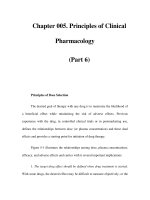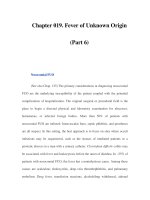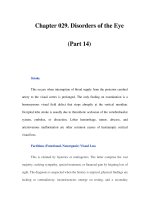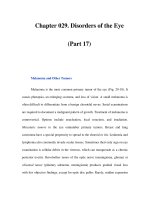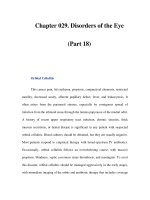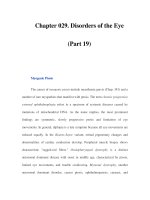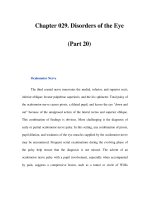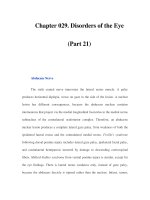Chapter 083. Cancer of the Skin (Part 6) potx
Bạn đang xem bản rút gọn của tài liệu. Xem và tải ngay bản đầy đủ của tài liệu tại đây (50.74 KB, 5 trang )
Chapter 083. Cancer of the Skin
(Part 6)
Biopsy
Any pigmented cutaneous lesion that has changed in size or shape or has
other features suggestive of malignant melanoma is a candidate for biopsy. The
recommended technique is an excisional biopsy, as that facilitates pathologic
assessment of the lesion, permits accurate measurement of thickness if the lesion
is melanoma, and constitutes treatment if the lesion is benign. For large lesions or
lesions on anatomic sites where excisional biopsy may not be feasible (such as the
face, hands, or feet), an incisional biopsy through the most nodular or darkest area
of the lesion is acceptable; this should include the vertical growth phase of the
primary tumor, if present. Incisional biopsy does not appear to facilitate the spread
of melanoma.
Staging
Once the diagnosis of malignant melanoma has been confirmed, the tumor
must be staged to determine prognosis and treatment. The history should probe for
evidence of metastatic disease, such as malaise, weight loss, headaches, visual
difficulty, or bone pain. The physical examination should be directed especially to
the skin, regional draining lymph nodes, central nervous system, liver, and spleen.
In the absence of signs or symptoms of metastasis, few laboratory or radiologic
tests are indicated for staging purposes. No tests or scans are routinely indicated
unless the history or physical examination suggests metastasis to a specific organ.
Once signs of metastasis exist, favored sites of spread, such as the liver, lungs,
bone, and brain, should be evaluated. Patients are classified into four stages (Table
83-3).
Melanoma: Treatment
Surgical Management
For a newly diagnosed cutaneous melanoma, wide surgical excision of the
lesion with a margin of normal skin is necessary to remove all malignant cells and
minimize possible local recurrence. The appropriate width of the margin is a
source of controversy. A World Health Organization trial that prospectively
randomized between 1- and 3-cm margins in 612 patients with thin malignant
melanomas (≤2 mm thick) reported that the narrower margin resulted in higher
rates of local recurrence but no difference in rates of nodal or distant metastases,
disease-free survival, or overall survival. Another large randomized trial
comparing 2- or 4-cm surgical margins for intermediate-thickness lesions (1–4
mm thick) also found no significant differences in overall survival. The following
margins can be recommended for primary melanoma: in situ: 0.5 cm; invasive up
to 1 mm thick: 1.0 cm; >1 mm: 2.0 cm. For lesions on the face, hands, and feet,
strict adherence to these margins must give way to individual considerations about
the constraints of surgery and minimization of morbidity. In all instances,
however, inclusion of subcutaneous fat in the surgical specimen facilitates
adequate thickness measurement and assessment of surgical margins by the
pathologist.
Sentinel Node Biopsy
Sentinel node biopsy (SLNB) has replaced elective regional nodal
dissection for the evaluation of regional nodal status. The initial draining node(s)
from the primary site is/are identified by injecting a blue dye and a radioisotope
around the primary site. The initial draining node(s) is/are then identified by
inspection of the nodal basin for the blue stained node and/or the node with high
uptake of the radioisotope. The identified nodes are removed and subjected to
careful histopathologic processing with serial section hematoxylin and eosin stains
as well as immunohistochemical stains that identify melanocytes. Sentinel lymph
node examination is a valuable staging tool, and in the instance of a negative
biopsy, SLNB may obviate the need for complete nodal dissection. Patients with
lesions <0.75 mm thick have an excellent prognosis and are not candidates for
SLNB unless other high-risk features are present (ulceration, shave biopsy with
base involved, etc.). At the other extreme, patients with lesions >4 mm thick have
such a high risk for distant metastases that controlling nodal disease may not alter
the ultimate clinical outcome. A subset of patients with lesions of intermediate
thickness may have a survival benefit from regional node dissection. SLNB is of
value in selecting patients who may benefit from adjuvant therapy. Survival
benefit of SLNB remains to be proven.
Adjuvant Therapy for Nodal Disease
For patients who are free of disease but at high risk for metastases, adjuvant
therapy that complements surgery is needed to destroy occult micrometastases,
prolong disease-free survival, and improve the cure rate. Many strategies have
been tried unsuccessfully. However, adjuvant interferon (IFN) α2b may be capable
of improving disease-free and overall survival in patients with nodal metastases
(stage III disease). The U.S. Food and Drug Administration has approved a high-
dose IFN adjuvant protocol consisting of 20 million units per square meter
intravenously 5 days a week for 4 weeks followed by 10 million units per square
meter subcutaneously three times a week for 11 months. In a large fraction of
patients, these doses of IFN are associated with severe toxicity, including a flulike
illness and decline in performance status. The toxicity in most patients reverses
promptly with lower doses and when therapy is stopped.
